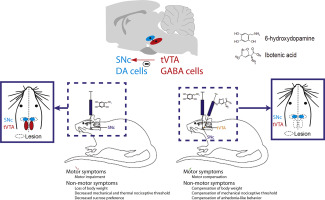当前位置:
X-MOL 学术
›
Neurobiol. Dis.
›
论文详情
Our official English website, www.x-mol.net, welcomes your feedback! (Note: you will need to create a separate account there.)
Ablation of the tail of the ventral tegmental area compensates symptoms in an experimental model of Parkinson's disease.
Neurobiology of Disease ( IF 6.1 ) Pub Date : 2020-02-19 , DOI: 10.1016/j.nbd.2020.104818 Fanny Faivre 1 , María-José Sánchez-Catalán 2 , Sandra Dovero 3 , Simone Bido 3 , Anil Joshi 4 , Erwan Bezard 3 , Michel Barrot 1
Neurobiology of Disease ( IF 6.1 ) Pub Date : 2020-02-19 , DOI: 10.1016/j.nbd.2020.104818 Fanny Faivre 1 , María-José Sánchez-Catalán 2 , Sandra Dovero 3 , Simone Bido 3 , Anil Joshi 4 , Erwan Bezard 3 , Michel Barrot 1
Affiliation

|
Parkinson's disease is a neurodegenerative disorder partly caused by the loss of the dopamine neurons of the nigrostriatal pathway. It is accompanied by motor as well as non-motor symptoms, including pain and depression. The tail of the ventral tegmental area (tVTA) or rostromedial tegmental nucleus (RMTg) is a GABAergic mesopontine structure that acts as a major inhibitory brake for the substantia nigra pars compacta (SNc) dopamine cells, thus controlling their neuronal activity and related motor functions. The present study tested the influence of suppressing this tVTA brake on motor and non-motor symptoms in a rat model of Parkinson's disease. Using behavioral approaches, we showed that male Sprague-Dawley rats with bilateral and partial 6-hydroxydopamine SNc lesion displayed motor impairments in the rotarod test, impairments that were no more present following a co-lesion of the tVTA. Using a larger set of behavioral tests, we then showed that such SNc lesion also led to non-motor symptoms, including lower body weight, lower mechanical nociceptive thresholds in the forceps test and lower thermal nociceptive thresholds in the incremented hot-plate test, and a decreased sucrose preference in a 2-bottle choice paradigm. The excitotoxic co-lesion of the tVTA led to compensation of body weight, mechanical nociceptive thresholds and anhedonia-like behavior. These findings illustrate the major influence that the tVTA exerts on the dopamine system, modulating the motor and non-motor symptoms related to a partial loss of dopamine cells.
中文翻译:

腹侧被盖区尾部的消融补偿了帕金森氏病实验模型中的症状。
帕金森氏病是一种神经退行性疾病,部分是由黑质纹状体途径的多巴胺神经元的丧失引起的。它伴有运动以及非运动症状,包括疼痛和抑郁。腹侧被盖区(tVTA)或腕间被盖核(RMTg)的尾巴是一种GABA能的中脑桥蛋白结构,可作为黑质致密部(SNc)多巴胺细胞的主要抑制性制动器,从而控制其神经元活性和相关的运动功能。本研究在帕金森氏病大鼠模型中测试了抑制tVTA制动对运动和非运动症状的影响。使用行为方法,我们发现患有双侧和部分6-羟基多巴胺SNc病变的雄性Sprague-Dawley大鼠在旋转脚架测试中显示出运动障碍,tVTA合并病变后不再存在的损伤。然后,通过使用更多的行为测试,我们发现这种SNc病变还导致了非运动症状,包括体重降低,钳子测试中的机械伤害性阈值降低,热板测试中的热伤害性阈值降低,以及2瓶选择范例中降低的蔗糖偏好。tVTA的兴奋毒性共损伤导致体重补偿,机械伤害阈值和类似快感不足的行为。这些发现说明了tVTA对多巴胺系统的主要影响,调节了与多巴胺细胞部分丢失有关的运动和非运动症状。然后我们发现,这种SNc病变还会导致非运动症状,包括体重降低,钳子测试中的机械伤害性阈值降低,热板测试中的热伤害性阈值降低,2-蔗糖偏好降低。瓶选择范例。tVTA的兴奋毒性共损伤导致体重补偿,机械伤害阈值和类似快感不足的行为。这些发现说明了tVTA对多巴胺系统的主要影响,调节了与多巴胺细胞部分丢失有关的运动和非运动症状。然后我们发现,这种SNc病变还会导致非运动症状,包括体重降低,钳子测试中的机械伤害性阈值降低,热板测试中的热伤害性阈值降低,2-蔗糖偏好降低。瓶选择范例。tVTA的兴奋毒性共损伤导致体重补偿,机械伤害阈值和类似快感不足的行为。这些发现说明了tVTA对多巴胺系统的主要影响,调节了与多巴胺细胞部分丢失有关的运动和非运动症状。和2瓶选择范例中的蔗糖偏好降低。tVTA的兴奋毒性共损伤导致体重补偿,机械伤害阈值和类似快感不足的行为。这些发现说明了tVTA对多巴胺系统的主要影响,调节了与多巴胺细胞部分丢失有关的运动和非运动症状。和2瓶选择范例中的蔗糖偏好降低。tVTA的兴奋毒性共损伤导致体重补偿,机械伤害阈值和类似快感不足的行为。这些发现说明了tVTA对多巴胺系统的主要影响,调节了与多巴胺细胞部分丢失有关的运动和非运动症状。
更新日期:2020-02-20
中文翻译:

腹侧被盖区尾部的消融补偿了帕金森氏病实验模型中的症状。
帕金森氏病是一种神经退行性疾病,部分是由黑质纹状体途径的多巴胺神经元的丧失引起的。它伴有运动以及非运动症状,包括疼痛和抑郁。腹侧被盖区(tVTA)或腕间被盖核(RMTg)的尾巴是一种GABA能的中脑桥蛋白结构,可作为黑质致密部(SNc)多巴胺细胞的主要抑制性制动器,从而控制其神经元活性和相关的运动功能。本研究在帕金森氏病大鼠模型中测试了抑制tVTA制动对运动和非运动症状的影响。使用行为方法,我们发现患有双侧和部分6-羟基多巴胺SNc病变的雄性Sprague-Dawley大鼠在旋转脚架测试中显示出运动障碍,tVTA合并病变后不再存在的损伤。然后,通过使用更多的行为测试,我们发现这种SNc病变还导致了非运动症状,包括体重降低,钳子测试中的机械伤害性阈值降低,热板测试中的热伤害性阈值降低,以及2瓶选择范例中降低的蔗糖偏好。tVTA的兴奋毒性共损伤导致体重补偿,机械伤害阈值和类似快感不足的行为。这些发现说明了tVTA对多巴胺系统的主要影响,调节了与多巴胺细胞部分丢失有关的运动和非运动症状。然后我们发现,这种SNc病变还会导致非运动症状,包括体重降低,钳子测试中的机械伤害性阈值降低,热板测试中的热伤害性阈值降低,2-蔗糖偏好降低。瓶选择范例。tVTA的兴奋毒性共损伤导致体重补偿,机械伤害阈值和类似快感不足的行为。这些发现说明了tVTA对多巴胺系统的主要影响,调节了与多巴胺细胞部分丢失有关的运动和非运动症状。然后我们发现,这种SNc病变还会导致非运动症状,包括体重降低,钳子测试中的机械伤害性阈值降低,热板测试中的热伤害性阈值降低,2-蔗糖偏好降低。瓶选择范例。tVTA的兴奋毒性共损伤导致体重补偿,机械伤害阈值和类似快感不足的行为。这些发现说明了tVTA对多巴胺系统的主要影响,调节了与多巴胺细胞部分丢失有关的运动和非运动症状。和2瓶选择范例中的蔗糖偏好降低。tVTA的兴奋毒性共损伤导致体重补偿,机械伤害阈值和类似快感不足的行为。这些发现说明了tVTA对多巴胺系统的主要影响,调节了与多巴胺细胞部分丢失有关的运动和非运动症状。和2瓶选择范例中的蔗糖偏好降低。tVTA的兴奋毒性共损伤导致体重补偿,机械伤害阈值和类似快感不足的行为。这些发现说明了tVTA对多巴胺系统的主要影响,调节了与多巴胺细胞部分丢失有关的运动和非运动症状。



























 京公网安备 11010802027423号
京公网安备 11010802027423号